Fill your paper with the breathings of your heart.”
―William Wordsworth
Poetry. It is a voice full of interpretation. It is your voice, whittled down to a story with just the necessary. Poetry is you. It is in you. Within your heart ready to break free; that is poetry. Poetry is a story nestled in your soul with the unnecessary words crossed out. It is in your “everyday” every day. Stop. Notice. Write. It isn’t poetry’s fault you are scared. What did it ever do to you? Well, maybe it did do something to you. Stand firm and show poetry what you have to say. Then say it!
I have an exercise for you that I read recently from a book called, Seeing the Blue Between compiled by Paul B. Janeczko. Poets write letters of advice and inspiration to young poets and then share some of their own poetry. One exercise, by Georgia Heard, struck me and I thought I would try it out. I think you should too.
She suggests a technique to see things in more detail and depth. She tries a two column exercise. Her example was the use of an ordinary word she sees in her mind or environment, like “green.” Then she places a more detailed description of what she is “seeing.” Is it a yellow green a pine green? What words best describe the word/phrase she is working with?
I tried this out when I was at the playground with my kids the other day. Here is a photo of what I noticed in my environment:
Then I started my one or two ordinary word descriptions and in my second column tried to take it a little further. To me it was like shoveling off a layer to get to the core of what I wanted to say. Here are my two columns:
Then I started my poem. I placed parts of the more descriptive lines with other words that I thought worked with the image.
It was time to workshop the poem. I began with what I thought would be one of the stanzas of the poem, however, I had not completely decided if the poem would have stanzas. I played with the words, added new ones and moved them around.
You can see here that I start to think stanzas were appropriate.
I began to rewrite using stanzas. Then wanted to rewrite the lines to see/hear them again but decided to draw connecting lines. I was doing away with stanzas.
What I found interesting is I added several words that were not part of my columns but then landed back on some of the initial ideas I had when I started the poem. It whittled down to this:
Air weaves through
the lifeless whispering trees.
Cylindrical towering trunks
carrying broom like bristled tops
sweep the dark misted sky.
Translucent drops
drip, dry on my cheek.
As I typed the poem and read it over and over I continued to workshop the lines. I hope you will think about using this exercise with your students or even yourself. I really enjoy workshopping a poem right beside my students. Even though I may have more experience and my word choice may be different from a first grader, I think going through the same process at the same time can be inspiring.


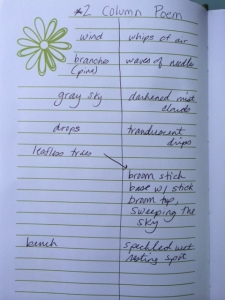
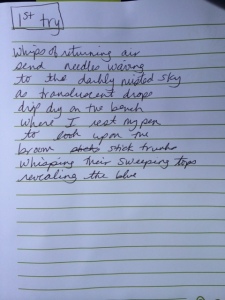
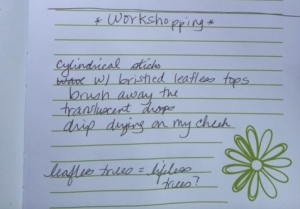
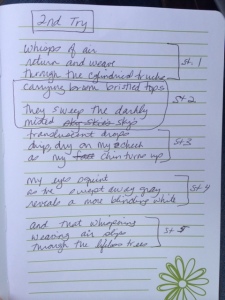
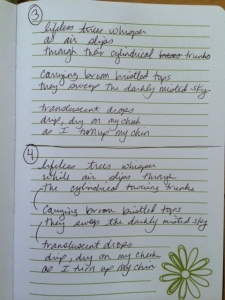
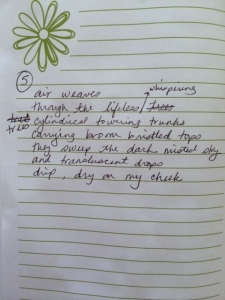

I love using this exercise “from ordinary to poetic” with my students. Thank you for sharing how you took this exercise and workshopped a whole poem with your students. You have encouraged me to extend how I will use this technique with my 3rd graders this year in just a couple weeks.
LikeLike
Thanks for the poem writing inspiration that I need to take the plunge into a style of writing that is not very comfortable for me. I will give it a try and with my students. I think it would be a nice breath of fresh air to give poetry a try in between writing lessons.
LikeLike
I appreciate you sharing this exercise, as well as your process. It really helps make the act of writing a poem, which is so scary for so many people, accessible.
I’ve never done this type of two-column chart before. I will certainly try it!
LikeLike
I enjoyed this peek into your notebook and your poetic creativity. Thanks for sharing!
LikeLike
Thanks for sharing your process, Betsy. I love the image of the “broom bristled” tops of the trees. Can’t wait to share this with students!
LikeLike
Thanks for sharing this idea and your work through the process. I’m going to try with a spring break environment.
LikeLike
Following your poetic mind is a treat. 🙂 Thank you!
LikeLike
I agree with all of the previous comments. It’s so helpful to see your process, Betsy. Thanks for the inspiring post.
LikeLike
This is a really helpful post, Betsy. I, too, loved seeing your notebook and the changes as you wrote and revised your poem. Georgia has done so much to help with poetry and when a teacher like you puts it to use and them adds a demonstration like this, it can’t help but nudge some perhaps reluctant poets to see more and write richer poetry. Will have to look for the 6-room idea Margaret has mentioned! I like how the treetops are sweeping the misty sky!
LikeLike
I like seeing the process. I am working on imagery this week, so I’ll try this two column prewriting. Georgia Heard gave me the 6-room form from “Awakening the Heart” that I have used over and over with students and adults. It’s magical. I also believe strongly in writing with my students. I am not always as skilled as a gifted child; they enjoy giving me help when we do our “criticycle” sessions.
LikeLike
Thanks for sharing the photos of your drafts. Reading about writing is good but I need to see the writing process too as a visual learner.
LikeLike